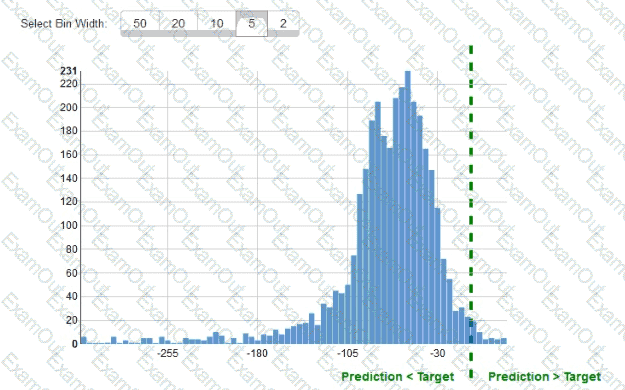A car company is developing a machine learning solution to detect whether a car is present in an image. The image dataset consists of one million images. Each image in the dataset is 200 pixels in height by 200 pixels in width. Each image is labeled as either having a car or not having a car.
Which architecture is MOST likely to produce a model that detects whether a car is present in an image with the highest accuracy?
While reviewing the histogram for residuals on regression evaluation data a Machine Learning Specialist notices that the residuals do not form a zero-centered bell shape as shown What does this mean?

A Data Scientist is building a model to predict customer churn using a dataset of 100 continuous numerical
features. The Marketing team has not provided any insight about which features are relevant for churn
prediction. The Marketing team wants to interpret the model and see the direct impact of relevant features on
the model outcome. While training a logistic regression model, the Data Scientist observes that there is a wide
gap between the training and validation set accuracy.
Which methods can the Data Scientist use to improve the model performance and satisfy the Marketing team’s
needs? (Choose two.)
A data scientist has a dataset of machine part images stored in Amazon Elastic File System (Amazon EFS). The data scientist needs to use Amazon SageMaker to create and train an image classification machine learning model based on this dataset. Because of budget and time constraints, management wants the data scientist to create and train a model with the least number of steps and integration work required.
How should the data scientist meet these requirements?
A Data Engineer needs to build a model using a dataset containing customer credit card information.
How can the Data Engineer ensure the data remains encrypted and the credit card information is secure?
A chemical company has developed several machine learning (ML) solutions to identify chemical process abnormalities. The time series values of independent variables and the labels are available for the past 2 years and are sufficient to accurately model the problem.
The regular operation label is marked as 0. The abnormal operation label is marked as 1 . Process abnormalities have a significant negative effect on the companys profits. The company must avoid these abnormalities.
Which metrics will indicate an ML solution that will provide the GREATEST probability of detecting an abnormality?
A machine learning (ML) specialist wants to create a data preparation job that uses a PySpark script with complex window aggregation operations to create data for training and testing. The ML specialist needs to evaluate the impact of the number of features and the sample count on model performance.
Which approach should the ML specialist use to determine the ideal data transformations for the model?
A Machine Learning Specialist is working for an online retailer that wants to run analytics on every customer visit, processed through a machine learning pipeline. The data needs to be ingested by Amazon Kinesis Data Streams at up to 100 transactions per second, and the JSON data blob is 100 KB in size.
What is the MINIMUM number of shards in Kinesis Data Streams the Specialist should use to successfully ingest this data?
A data scientist is working on a forecast problem by using a dataset that consists of .csv files that are stored in Amazon S3. The files contain a timestamp variable in the following format:
March 1st, 2020, 08:14pm -
There is a hypothesis about seasonal differences in the dependent variable. This number could be higher or lower for weekdays because some days and hours present varying values, so the day of the week, month, or hour could be an important factor. As a result, the data scientist needs to transform the timestamp into weekdays, month, and day as three separate variables to conduct an analysis.
Which solution requires the LEAST operational overhead to create a new dataset with the added features?
A company that runs an online library is implementing a chatbot using Amazon Lex to provide book recommendations based on category. This intent is fulfilled by an AWS Lambda function that queries an Amazon DynamoDB table for a list of book titles, given a particular category. For testing, there are only three categories implemented as the custom slot types: "comedy," "adventure,” and "documentary.”
A machine learning (ML) specialist notices that sometimes the request cannot be fulfilled because Amazon Lex cannot understand the category spoken by users with utterances such as "funny," "fun," and "humor." The ML specialist needs to fix the problem without changing the Lambda code or data in DynamoDB.
How should the ML specialist fix the problem?

